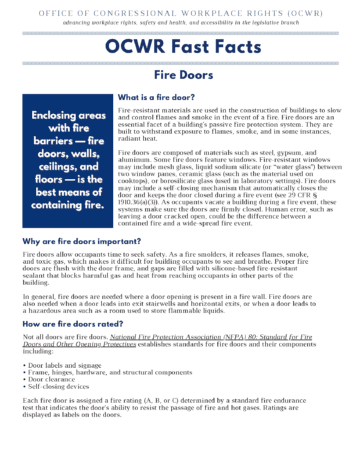What is a fire door?
Fire-resistant materials are used in the construction of buildings to slow and control flames and smoke in the event of a fire. Fire doors are an essential facet of a building’s passive fire protection system. They are built to withstand exposure to flames, smoke, and in some instances, radiant heat.
Fire doors are composed of materials such as steel, gypsum, and aluminum. Some fire doors feature windows. Fire-resistant windows may include mesh glass, liquid sodium silicate (or “water glass”) between two window panes, ceramic glass (such as the material used on cooktops), or borosilicate glass (used in laboratory settings). Fire doors may include a self-closing mechanism that automatically closes the door and keeps the door closed during a fire event (see 29 CFR § 1910.36(a)(3)). As occupants vacate a building during a fire event, these systems make sure the doors are firmly closed. Human error, such as leaving a door cracked open, could be the difference between a contained fire and a wide-spread fire event.
Why are fire doors important?
Fire doors allow occupants time to seek safety. As a fire smolders, it releases flames, smoke, and toxic gas, which makes it difficult for building occupants to see and breathe. Proper fire doors are flush with the door frame, and gaps are filled with silicone-based fire-resistant sealant that blocks harmful gas and heat from reaching occupants in other parts of the building.
In general, fire doors are needed where a door opening is present in a fire wall. Fire doors are also needed when a door leads into exit stairwells and horizontal exits, or when a door leads to a hazardous area such as a room used to store flammable liquids.
How are fire doors rated?
Not all doors are fire doors. National Fire Protection Association (NFPA) 80: Standard for Fire Doors and Other Opening Protectives establishes standards for fire doors and their components including:
- Door labels and signage
- Frame, hinges, hardware, and structural components
- Door clearance
- Self-closing devices
Each fire door is assigned a fire rating (A, B, or C) determined by a standard fire endurance test that indicates the door’s ability to resist the passage of fire and hot gases. Ratings are displayed as labels on the doors.

